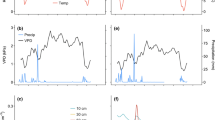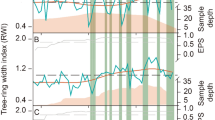Abstract
Although precipitation plays a central role in structuring Africa’s miombo woodlands, remarkably little is known about plant-water relations in this seasonally dry tropical forest. Therefore, in this study, we investigated xylem vulnerability to cavitation for nine principal tree species of miombo woodlands, which differ in habitat preference and leaf phenology. We measured cavitation vulnerability (Ψ50), stem-area specific hydraulic conductivity (K S), leaf specific conductivity (K L), seasonal variation in predawn water potential (ΨPD) and xylem anatomical properties [mean vessel diameter, mean hydraulic diameter, mean hydraulic diameter accounting for 95 % flow, and maximum vessel length (V L)]. Results show that tree species with a narrow habitat range (mesic specialists) were more vulnerable to cavitation than species with a wide habitat range (generalists). Ψ50 for mesic specialists ranged between −1.5 and −2.2 MPa and that for generalists between −2.5 and −3.6 MPa. While mesic specialists exhibited the lowest seasonal variation in ΨPD, generalists displayed significant seasonal variations in ΨPD suggesting that the two miombo habitat groups differ in their rooting depth. We observed a strong trade-off between K S and Ψ50 suggesting that tree hydraulic architecture is one of the decisive factors setting ecological boundaries for principal miombo species. While vessel diameters correlated weakly (P > 0.05) with Ψ50, V L was positively and significantly correlated with Ψ50. ΨPD was significantly correlated with Ψ50 further reinforcing the conclusion that tree hydraulic architecture plays a significant role in species’ habitat preference in miombo woodlands.






Similar content being viewed by others
References
Andrade JL, Meinzer FC, Goldstein G, Holbrook NM, Cavelier J, Jackson P, Silvera K (1998) Regulation of water flux through trunks, branches, and leaves in trees of a lowland tropical forest. Oecologia 115:463–471
Beikircher B, Mayr S (2008) The hydraulic architecture of Juniperus communis L. ssp. communis: shrubs and trees compared. Plant Cell Environ 31:1545–1556
Bhaskar R, Ackerly DD (2006) Ecological relevance of minimum seasonal water potentials. Physiol Plant 127:353–359
Brodribb T, Hill RS (1999) The importance of xylem constraints in the distribution of conifer species. New Phytol 143:365–372
Campbell B, Frost P, Byron N (1996) Miombo woodlands and their use: overview and key issues. In: Campbell B (ed) The miombo in transition: woodlands and welfare in Africa. CIFOR, Bogor, pp 1–10
Canham AC, Froend RH, Stock WD (2009) Water stress vulnerability of four Banksia species in contrasting ecohydrological habitats on the Gnangara Mound, Western Australia. Plant Cell Environ 32:64–72
Chen WJ, Zhang Q, Cao FK (2009) Inter-species variation of photosynthetic and xylem hydraulic traits in the deciduous and evergreen Euphorbiaceae tree species from a seasonally tropical forest in south-western China. Ecol Res 24:65–73
Chidumayo EN (1987) Species structure in Zambian miombo woodland. J Appl Ecol 3:109–118
Chidumayo EN (1997) Miombo ecology and management: an introduction. Stockholm Environmental Institute, Stockholm
Choat B, Ball MC, Luly GJ, Holtum MAJ (2005) Hydraulic architecture of deciduous and evergreen dry rainforest tree species from north-eastern Australia. Trees 19:305–311
Choat B, Sack L, Holbrook NM (2007) Diversity of hydraulic traits in nine Cordia species growing in tropical forests with contrasting precipitation. New Phytol 175:686–698
Cochard H, Cruiziat P, Tyree MT (1992) Use of positive pressure to establish vulnerability curves. Plant Physiol 100:205–209
Cole MM (1963) Vegetation and geomorphology in northern Rhodesia: an aspect of the distribution of the savanna of central Africa. Geogr J 129:290–305
Edwards JE, Diaz M (2006) Ecological physiology of Pereskia guamacho, a cactus with leaves. Plant Cell Environ 29:247–256
Engelbrecht BMJ, Velez V, Tyree MT (2000) Hydraulic conductance 365 of two co-occuring Neotropical understorey shrubs with different habitat preferences. Ann For Sci 57:201–208
Ewers WF, Fisher JB (1989) Techniques for measuring vessel lengths and diameters in stems of woody plants. Am J Bot 76:645–656
Fanshawe DB (1971) The vegetation of Zambia. Government Printers, Lusaka
Frost P (1996) The ecology of miombo woodlands. In: Campbell B (ed) The miombo in transition: woodlands and welfare in Africa. CIFOR, Bogor, pp 11–57
Gillespie TW, Grijalva A, Farris CN (2000) Diversity, composition, and structure of tropical dry forest in Central America. Plant Ecol 147:37–47
Guy PR (1989) The influence of elephants and fire on a Brachystegia-Julbernardia woodland in Zimbabwe. J Trop Ecol 54:215–226
Hacke UG, Sperry JS, Pittermann J (2000) Drought experience and cavitation resistance in six shrubs from the Great Basin, Utah. Basic Appl Ecol 1:31–41
Jacobsen AL, Pratt RB, Davis DS, Ewers WF (2007) Cavitation resistance and seasonal hydraulics differ among three arid Californian plant communities. Plant Cell Environ 30:1599–1609
Kolb KJ, Davis DS (1994) Drought tolerance and xylem embolism in co-occurring species of coastal sage and chaparral. Ecology 75:648–659
Kolb KJ, Sperry JS, Lamont BB (1996) A method for measuring xylem hydraulic conductance and embolism in entire root and shoot systems. J Exp Bot 47:1805–1810
Lawton RM (1978) A study of the dynamic ecology of Zambian vegetation. J Ecol 66:175–198
Lopez OR, Kursar TA, Cochard H, Tyree MT (2005) Interspecific variation in xylem vulnerability to cavitation among tropical tree and shrub species. Tree Physiol 25:1553–1562
Maherali H, Pockman TW, Jackson BR (2004) Adaptive variation in the vulnerability of woody plants to xylem cavitation. Ecology 85:2184–2199
Malaisse F (1978) The miombo ecosystem. In: FAO (ed) Tropical forest ecosystems: a state-of-knowledge report prepared by UNESCO/UNEP/FAO. UNESCO, Paris, pp 589–606
Markesteijn L, Poorter L, Paz H, Sack L, Bongers F (2011) Ecological differentiation in xylem cavitation resistance is associated with stem and leaf structural traits. Plant Cell Environ 34:137–148
Mencuccini M, Comstock J (1997) Vulnerability to cavitation in populations of two desert species, Hymenoclea salsola and Ambrosia dumosa, from different climatic regions. J Exp Bot 48:1323–1334
Pammenter NW, Willigen CV (1998) A mathematical and statistical analysis of the curves illustrating vulnerability to xylem to cavitation. Tree Physiol 18:589–593
Patino S, Tyree MT, Herre EA (1995) Comparison of hydraulic architecture of woody plants of differing phylogeny and growth form with special reference to free standing and hemi-epiphytic Ficus species from Panama. New Phytol 129:125–134
Pockman WT, Sperry JS (2000) Vulnerability to xylem cavitation and the distribution of Sonoran desert vegetation. Am J Bot 87:1287–1299
Schmidhalter U (1997) The gradient between pre-dawn rhizoplane and bulk soil matric potentials, and its relation to the pre-dawn root and leaf water potentials of four species. Plant Cell Environ 20:953–960
Smith P, Allen Q (2004) Field guide to the trees and shrubs of the miombo woodlands. Royal Botanical Gardens Kew, London
Sobrado MA (1997) Embolism vulnerability in drought-deciduous and evergreen species of a tropical dry forest. Acta Ecol 18:383–391
Sperry JS, Hacke UG (2002) Desert shrub water relations with respect to soil characteristics and plant functional type. Funct Ecol 16:367–378
Sperry JS, Donnelly JR, Tyree MT (1988) A method for measuring 410 hydraulic conductivity and embolism in xylem. Plant Cell Environ 11:35–40
Stratton L, Goldstein G, Meinzer FC (2000) Stem water storage capacity and efficiency of water transport: their habitat significance in a Hawaiian dry forest. Plant Cell Environ 23:99–106
Timberlake JR, Calvert GM (1993) Preliminary root atlas for Zimbabwe and Zambia. Zimbabwe bulletin of forestry research no. 10. Forestry Commission, Harare
Tyree MT, Sperry JS (1989) Vulnerability of xylem to cavitation and embolism. Annu Rev Plant Physiol Plant Mol Biol 40:19–38
Tyree MT, Zimmermann MH (2002) Xylem structure and the ascent of sap, 2nd edn. Springer, Berlin
Van der Willigen C, Sherwin HW, Pammenter NW (2000) Xylem hydraulic characteristics of subtropical trees from contrasting habitats grown under identical environmental conditions. New Phytol 145:51–59
Vinya R, Malhi Y, Brown N, Fisher JB (2012) Habitat coordination between branch hydraulic properties and leaf habitat traits in miombo woodlands: implications for water stress management and species habitat preference. Acta Physiol Plant 34:1701–1710
Wheeler JK, Sperry JS, Hacke UG, Hoang N (2005) Inter-vessel pitting 431 and cavitation in woody Rosaceae and other vesselled plants: a basis for a safety versus efficiency trade-off in xylem transport. Plant Cell Environ 28:800–812
White F (1983) The vegetation of Africa: a descriptive memoir to accompany the UNESCO/AETFAT/UNSO vegetation map of Africa. UNESCO, Paris
Williams LE, Araujo FJ (2002) Correlations among predawn leaf, midday leaf, and midday stem water potential and their correlations with other measures of soil and plant water status in Vitis vinifera. J Am Soc Hortic Sci 127:448–454
Zar JH (2010) Biostatistical analysis, 5th edn. Pearson Education International, London
Zimmermann MH (1983) Xylem structure and the ascent of sap. Springer, Berlin
Zimmermann MH, Jeje AA (1981) Vessel length in stems of some American woody species. Can J Bot 59:1882–1892
Acknowledgments
The lead author was funded by a scholarship from the Association of Commonwealth Universities; Copperbelt University provided financial support during field work. We wish to thank the principal of the Zambia Forestry College, the late Mr Saxon N. Siame who provided laboratory work space at the wet miombo site. The District Forestry Officer for Choma district Jones Mulomba is greatly appreciated for his logistical support during our stay on the dry site. Lab assistants in Zambia, Milimo Miyoba and Metson Kasowe are also acknowledged.
Author information
Authors and Affiliations
Corresponding author
Additional information
Communicated by Ram Oren.
Electronic supplementary material
Below is the link to the electronic supplementary material.
Rights and permissions
About this article
Cite this article
Vinya, R., Malhi, Y., Fisher, J.B. et al. Xylem cavitation vulnerability influences tree species’ habitat preferences in miombo woodlands. Oecologia 173, 711–720 (2013). https://doi.org/10.1007/s00442-013-2671-2
Received:
Accepted:
Published:
Issue Date:
DOI: https://doi.org/10.1007/s00442-013-2671-2




